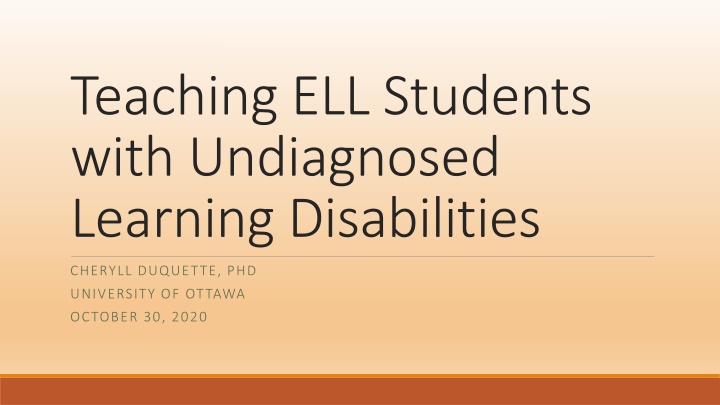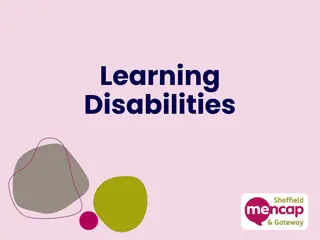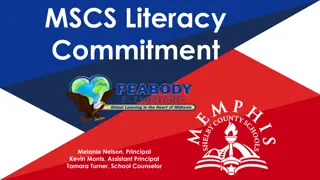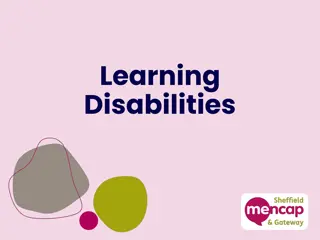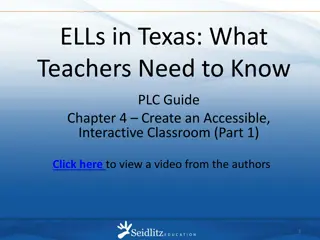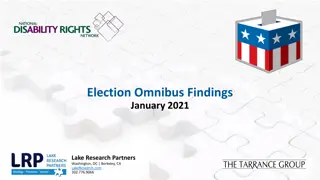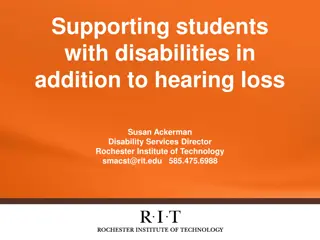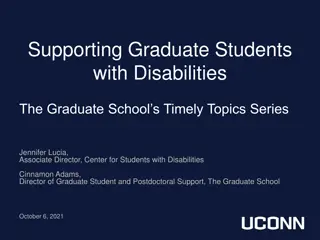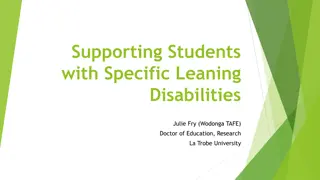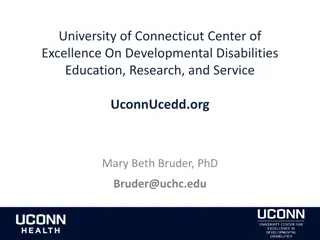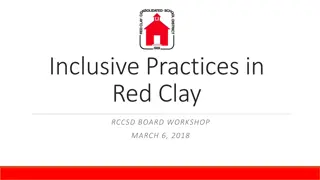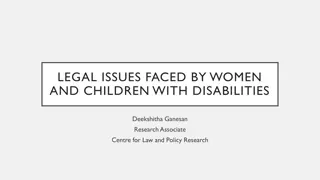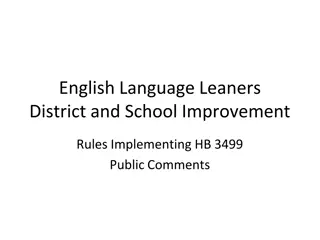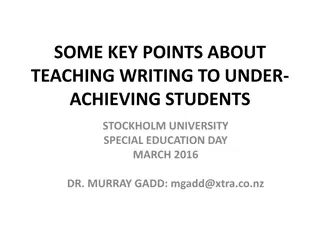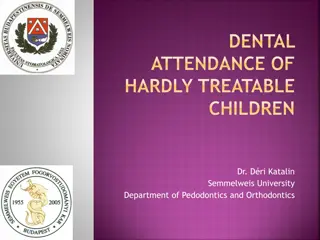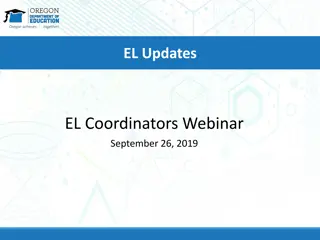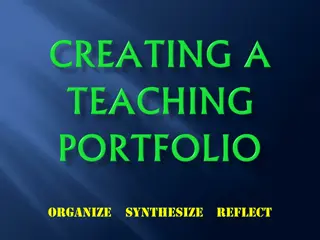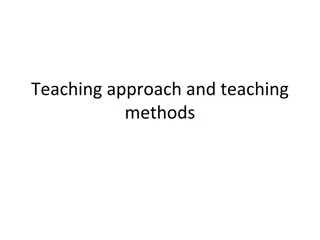Effective Strategies for Teaching ELL Students with Learning Disabilities
Teaching ELL students with undiagnosed learning disabilities requires understanding the symptoms of LDs, incorporating direct instruction, encoding strategies, peer-mediated learning, and fostering growth mindset and metacognition. Explore various types of learning disabilities and their prevalence and causes to enhance your teaching approach.
Download Presentation

Please find below an Image/Link to download the presentation.
The content on the website is provided AS IS for your information and personal use only. It may not be sold, licensed, or shared on other websites without obtaining consent from the author.If you encounter any issues during the download, it is possible that the publisher has removed the file from their server.
You are allowed to download the files provided on this website for personal or commercial use, subject to the condition that they are used lawfully. All files are the property of their respective owners.
The content on the website is provided AS IS for your information and personal use only. It may not be sold, licensed, or shared on other websites without obtaining consent from the author.
E N D
Presentation Transcript
Teaching ELL Students with Undiagnosed Learning Disabilities CHERYLL DUQUETTE, PHD UNIVERSITY OF OTTAWA OCTOBER 30, 2020
Learning Goals Learning Goals Participants will be familiar with the symptoms of LDs and be able to use the list of symptoms to conduct informal observations. Participants will be able to use direct instruction and incorporate encoding strategies into their lessons. Participants will be able to use peer mediated learning in their practice. Participants will be familiar with metacognition, study skills, growth mindset, and self-efficacy and be able to include them in their practice.
Agenda Agenda What are LDs? Activity Think of a student Direct instruction and encoding strategies Activity Develop a lesson using the template Sharing your lessons Peer-mediated learning Growth mindset, metacognition, study skills, self-efficacy Questions and answers Workshop evaluation
What are Learning Disabilities? What are Learning Disabilities? Learning disabilities refer to different disorders that affect the acquisition, retention, understanding, organization, or use of verbal and/or non-verbal information. They range from mild, to moderate, and to severe. Individuals with LDs have an IQ score at least in the average range. (LDAO)
Prevalence and Causes Prevalence and Causes Prevalence - LDs affect approximately 3.2% of the population (LDAO) There are several possible causes: Genetic, Head injury, Nutritional deprivation, Exposure to alcohol while in the womb, and Low birth weight.
Types of LDs Types of LDs Learning disabilities is an umbrella term. The three main types of LDs are Dyslexia difficulty with reading (oral, comprehension, speed), writing, spelling, and speaking, phonological awareness), 85% of people with LDs have dyslexia Dysgraphia difficulty with handwriting or printing, spelling, and organization of ideas Dyscalculia difficulty in math computation and problem solving, time and money
Skill Acquisition Skill Acquisition LDs can affect the acquisition of several skills. Reading (e.g., phonological awareness, decoding, comprehension) Written language (e.g., spelling, written expression) Oral language (e.g., listening, speaking, understanding) Mathematics (e.g., computation, problem solving)
Psychological Processes Psychological Processes Phonological processing and discriminating between letters and sounds Memory and attention Processing speed Language processing Executive function (goal-setting, planning, self-regulation) Difficulty following directions Sequencing, disorganization, difficulty adjusting to change
Symptoms of LDs (Handout 1) Symptoms of LDs (Handout 1) Learning disabilities are invisible but the signs are seen at home, school, work and in the community. Each individual will have different symptoms. Can t seem to remember the sounds and letters of the alphabet, high frequency words, vocabulary needs more repetition Express themselves better orally than in writing poor grammar, lack of capitals and punctuation, vocabulary, missing words Avoidance of activities that involve reading and writing Poor reading fluency and comprehension Poor spelling can t sound out the words or remember how to spell high frequency words, incorrect and inconsistent spelling of words Copying is inaccurate
Symptoms of LDs Symptoms of LDs Poor handwriting Poor organization of ideas in written expression generally poor quality written work Poor sequencing and can t seem to follow directions May need more breaks Low self-esteem and low self-confidence I can t , attributes success to luck rather than hard work, feeling of not being worthy of the achievement
Symptoms of LDs Symptoms of LDs Can t seem to meet expectations ability does not match performance (e.g., fine orally, but can t seem to read or write) Poor test results Forgets, argues, postpones, procrastinates, doesn t complete assignments, and misses deadlines Inability to focus (short attention span) Problems with integration putting information in the right order, making sense of the information, and using it to form complete thoughts
Symptoms of LDs Symptoms of LDs Difficulty understanding and expressing feelings verbally and interpreting verbal language and non-verbal cues Problems with relationships perceiving social situations appropriately, regulating emotions, reacting impulsively, getting along with others Anger due to frustration and quicker to anger than others Seems unmotivated Symptoms usually appear in both the first language and other languages that are learned Possible comorbidity with anxiety and depression if LDs are undiagnosed
Some Potential Difficulties Related to Language Some Potential Difficulties Related to Language Learning or to Special Education Needs Learning or to Special Education Needs Behaviour Possible Explanation in Language Learning Context Possible Explanation as LDs Adds or deletes words May not yet know the word, may not have learned the words, more repetition Has memory/oral language processing difficulties Is easily distracted Doesn t understand, is overloaded with new information, requires more visual support Has an auditory processing problem or ADD/ADHD Has trouble following directions Doesn t know the vocabulary in the instructions Has sequencing, memory, or reading comprehension difficulties Avoids writing Lacks confidence or is not comfortable with having multiple drafts of work before the final version Has fine motor difficulties and limited expressive language Can t retell a story in sequence or summarize a plot or content of a passage Is unfamiliar with too much of the vocabulary of the story or the text Has organization or processing problems
Some Similar Symptoms but not LDs Some Similar Symptoms but not LDs Mental health problems anxiety, depression, PTSD problems with attention, concentration, memory, decreased motivation Problems with family and friends e.g., financial, food security, health Irregular attendance, frequently late Vision or hearing impairment Mismatch between the teacher s style and their preferred learning modality/modalities or previous school experience Limited experience with formal education Limited opportunities to speak English outside of classes Low IQ
Consider One Student (Handout 2) Consider One Student (Handout 2) Name of Student Strengths/Interests Difficulties/Symptoms Strategies
Adults with LDs and Assessment Adults with LDs and Assessment This video is about a young woman who is struggles with reading, written expression, and math. She suspects she has LDs and decides to have an assessment. https://www.youtube.com/watch?v=9CXLyA5CrMI
Direct Instruction (Handout 3) Direct Instruction (Handout 3) Direct instruction is a method of instruction developed by Gagn and is aligned with the cognitive information processing (CIP) model of learning. CIP: Sensory memory short term memory long term memory Using the direct instruction method and encoding strategies helps transfer information and skills into the long term memory where they are stored and recalled for use.
Direct Instruction Direct Instruction Direct instruction has been shown to improve the learning of students with LDs. When done well, it provides (a) ample opportunity for students with LDs to be engaged in the learning process, (b) multiple opportunities to respond to instruction, (c) opportunities to receive accurate and timely corrective feedback on their responses, and (d) opportunities to practise the corrected responses. Please refer to Handout 3: Direct Instruction
Direct Instruction Direct Instruction Lesson topic Goals e.g., The students will be able to express verbs in the future tense Introduction Gain attention (e.g., It is time to start. ), discuss the agenda for the day and inform students of the goals of the lesson (e.g., Think of two things you will do tomorrow. These activities will be done in the future. We will be learning how to form verbs in the future tense. ) Recall previous information you can review, ask students questions, or review common experiences, students with LDs need to build new knowledge on previously learned information.
Direct Instruction Direct Instruction Present the material organized, step-by-step, use encoding strategies Encoding strategies Multiple means of instruction - more than one learning modality VAK/T (visual, auditory, kinesthetic/tactile), videos, PPTs, role plays Chunking break the information into smaller sections or sequential steps Repetition Repeat important points many times. Have three or four key words that relate to the lesson and repeat them. Scaffolding demonstration, anchor charts Visuals graphic organizers, Venn diagrams, figures, pictures, objects, gestures, facial expressions
Direct Instruction Direct Instruction Present the material Also use the following strategies to help students with LDs learn. Signal Say, This is important. Then circle the point, underline it, or use different coloured markers. When writing words on the board, say them at the same time that you write them. Students can see and hear the words. Clarity Use short, simple sentences, and simply worded instructions or directions. Engage students with LDs in the lesson with questions you know they can answer or open-ended questions. Use think-pair-share activities. Ensure that your presentation is well organized; it helps students with LDs when it is time to study.
Direct Instruction Direct Instruction Guided practice and feedback Give the students a chance to practise the activity and provide feedback. For example, in pairs have students tell each other the two things they have to do tomorrow. Then they will write the sentences. You listen to the students talking and have them read their sentences to you. Provide feedback and correct immediately, if necessary. Have students share their sentences with others. Feedback is critical to learning the correct information, pronunciation, vocabulary, grammar, or spelling. Then the students with LDs need to practise the information or skill often. Perfect practice makes perfect.
Direct Instruction Direct Instruction Independent practice Students can practise the skill or use the information on their own or in pairs. Again, demonstrate what is to be done and provide feedback on the students work. Pay particular attention to the students with LDs to ensure they are using the information correctly (e.g., forming the future tense). Provide many opportunities to practise using the skill or information. Assessment Ideally, you should plan the assessment after you decide on the goals. If the students are to be able to write and say the future tense correctly, then the instruction and practice exercises must help them reach this goal. Decide how you will know if the students can form and use the future tense correctly. Reflection What went well? What sections could be improved?
Activity 2 Activity 2 Using the direct instruction template shown in Handout 3, develop a lesson. Write everything in point form. In the blank column on the right, think about the student whom you feel may have LDs and make particular notes pertaining to meeting the needs of that student. For example, in the presentation part of the lesson, call on that person if they seem to know the answer. Use examples that may tap into their interests. In the guided practice section, make a note to go to this person first and check their work. Provide quiet praise or acknowledgement. If possible, check this person s work a second time.
Teaching the Alphabet Teaching the Alphabet Teach five letters at a time, with lots of repetition for your students with LDs. Using a PPT presentation, project a letter and show pictures of objects from their everyday lives and interests that begin with the sound. Label the pictures. Say the names of the objects with the students. Have students make their own dictionaries with the letter (upper and lower case) and one or two hand-drawn pictures of objects that begin with the sound. Using their phones, have students take pictures of each page. Encourage the students with LDs to refer to them often. Teach the alphabet song. Encourage them to sing it silently in their heads. Use alphabet packs to practise the order of the letters and the sounds. Play bingo with cards with the upper and lower case letters on them. Use bingo to teach the letters and the sounds associated with them.
Reading Reading Play Wheel of Fortune with sentences you are studying. Students are issued money and can buy letters. Create your own books or any type of passage that would appeal to the students with the vocabulary you are studying and sight words. Have students read them with a partner. The more capable partner reads first (tutor) and the student with LDs (tutee) reads next. In pairs, have students create their own passages (e.g., a short report on the weekend s soccer matches) and read them to others.
Extension and Tiered Activities, RTI Extension and Tiered Activities, RTI Extension activities Activities that can be done by students who have completed the main activity. They extend the knowledge of the topic. This leaves you free to help individuals or small groups of students who need a second explanation or more supervision and corrective feedback. Tiered activities Start by developing two activities for a lesson. The first one is what everyone would be expected to complete. The second tier activity could include most of the main one plus an extension type of activity. Assuming that the others can work independently, you can work more intensely with students who may have LDs on the first tier activity. RTI Response to intervention there are three levels: whole class (most of the students), a small group, 1:1
Peer Mediated Learning Peer Mediated Learning Peer mediated learning is a classroom-based practice where students work in pairs to complete activities. A student (tutee) provides oral or written responses while the other student (tutor) provides immediate corrective feedback and clarification of concepts. It has been shown to increase opportunities for students with LDs to respond and receive immediate corrective feedback and increase time on task and practice. Adults with LDs have indicated being motivated by working with others.
Peer Mediated Learning Peer Mediated Learning Use it to supplement instruction for the review of concepts and skills and additional practice. The activities should be highly structured and short in duration (15-30 min.), with goals for each session. For example, practice with vocabulary words, grammatical structures, or practice tests could be possible activities for your students. Pair the students appropriately. Match a student with a higher skill level with one of the students with a lower skill level. However, too much of a gap in skill level is not recommended. Also consider which students will likely work well together.
Growth Mindset Growth Mindset Mindset is a disposition toward the belief that intelligence is either fixed, an immoveable trait, or a malleable process that can be improved through hard work, practice, and experience. Those who believe in growth mindset contend that ability can be enhanced, and they are more likely to strive towards personal learning goals or improvement goals to advance their skills. For those with fixed mindsets, the ultimate goal of learning is to demonstrate high intelligence through the attainment of a prescribed performance standard (e.g., a mark on an exam) rather than individual improvement (Dweck, 1986).
Growth Mindset and Self Growth Mindset and Self- -Efficacy Efficacy Self-efficacy is a person s belief in their own agency and ability to produce a preferred outcome in their life (Bandura & Locke, 2003). Some students with LDs may have a fixed mindset and low self-efficacy and will show less motivation. If an individual thinks they can t achieve the desired result (e.g., due to a fixed mindset), they are less willing to persist and do the hard work necessary to achieve their goals. Supporting a growth mindset Provide verbal encouragement and support; help the student set realistic, short term goals; provide instruction that supports learning; engage the student in the lessons; and use the students interests and goals to inform lesson planning.
Metacognition Metacognition Metacognition is thinking about your thinking that usually takes place in the form of a mental conversation in your short term/working memory. It is a way to check that a) you understand and b) you are doing the task correctly. It has been shown to play a role in communication, reading comprehension, concentration, memory, and problem solving. Students with LDs don t always know to assess their thinking or how to do it. Metacognition also involves: goal setting, planning how to accomplish the goal e.g., when to study and where, self-evaluation and monitoring their learning, and help-seeking from the teacher or a knowledgeable peer.
Metacognition Metacognition Strategies Encourage students to set goals for themselves and plan how to achieve them. Teach students to ask themselves: What parts can I do? How else could I do this? What parts do I find difficult or I don t understand? Who can help me (teacher, peer)? Model verbalizing your own thinking. Use think-pair-share and peer mediated activities. Encourage students to ask for help when they do not understand.
Metacognition Metacognition Discuss self-regulation with all of the students Talk about how they resisting distractions (e.g., phones), motivate themselves to complete school work, structure the environment so that it is conducive to studying, participate in class, plan and organize their academic activities, and study when there are more interesting things to do Discuss how they study.
Study Skills Study Skills Study skills are competencies that allow students to acquire, record, organize, synthesize, remember, and use information. Students with LDs often use less effective study skills (e.g., read their notes, rote rehearsal). They need to be mentally engaged to achieve deep learning. Teach study skills and provide summaries of important concepts (e.g., how to form verb tenses). Planning spread studying over a few days Strategies mnemonics, note-taking, making diagrams, using flashcards paper or digital, highlighting, imagine various associations, put ideas in their own words, test themselves Help seeking ask the teacher or peers for assistance
Self Self- -Efficacy Efficacy Two videos on self-efficacy: What is self-efficacy? and The Importance of Self- Efficacy. https://www.youtube.com/watch?v=QyhhXuWHQLM https://www.youtube.com/watch?v=VW5v6PQ5PEc
Implications for Instructors Implications for Instructors Know your students strengths, difficulties, interests, and goals. Be knowledgeable about the symptoms of LDs. Structure your lessons to enhance and strengthen the learning for low-achieving students (e.g., direct instruction + encoding strategies, peer mediated activities). Promote a growth mindset and higher self-efficacy among your students with LDs. Help students learn how to learn, regulate their learning, and study. Strive to be that approachable, supportive, and caring instructor.
Resources Resources Learning Disabilities Association of Ontario https://www.ldao.ca/ Learning Disabilities Association of Canada https://www.ldac-acta.ca/ Pirie, P. Assessing Learning Disabilities in ESL https://www.teslontario.org/uploads/research/ESLLDStrategies.pdf Duquette, C., & Fullarton, S. With an LD, you re always mediocre and expect to be mediocre. https://ojs.lib.uwo.ca/index.php/eei/article/view/7637/6254
Concluding Items Concluding Items Return to the handout on one student (Handout 2) and add notes to any of the columns. Review your goal(s) for this workshop and jot down ideas that will help you reach them. Please complete the workshop evaluation form. Questions?
